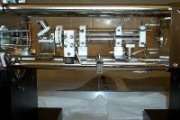Viewings: 9311

Recently physicists from Australia did something that was previously considered impossible. They are using a special technique, were able to photograph the shadow that cast a single atom of ytterbium. According to scientists, they have developed the technique can be successfully used in cell biology - it will be possible to photograph different moments in the life of proteins and DNA.
As we remember, the shadow can throw any object capable of incident photons or absorb them. Therefore, from the point of view of physics, there is nothing surprising in the fact that atoms have shadows - they too can absorb the photons. However, this assumption for a long time it was not possible to verify in practice. Because in order to prove this hypothesis, the shadow of the atom should just... to photograph! But it also was very, very difficult.
Recently, however, scientists from Griffith University (Australia) was the first to do it. They received a clear enough picture of the shadow of the atom rare earth metal ytterbium. More precisely, not atom and ion - in the experiment involved a single 174Yb+held in ultrahigh vacuum conditions with the help of so-called traps Paul.
Let me remind you that such a person is called a device consisting of four hyperbolic electrodes. In case of parallel traps they are parallel to each other, and in the case quadrouple option (which was used in the experiment) - as the "crosswise". These electrodes alternating current, it creates an electric field, which holds ion. However, if to be more exact, ion still goes on and does some oscillatory motion near a fixed point.
So after physics "lured" single-ion ytterbium into this trap, they sent him electromagnetic radiation with a wavelength in 369,5 nm. The whole beam was focused to a few micrometers. All this created the lighting field and at the same time ensured laser cooling. Past the light was going through a phase Fresnel lens (a special type of lenses, consisting not of solid polished piece of glass with a spherical or other surfaces (as a normal lens), and some adjacent to each other concentric rings of small thickness, which in the section have the form of a special prisms profile) and served on a cooled CCD camera.
The result is a single and not too long action of light on atoms enough to get a clear picture. This exposure was 0.05-1 seconds. At the same time it should be noted that in this case the notion of "distinct" some did not coincide with the value adopted for the characteristic photos macroscopic objects. Here there was not referring to the resolution and contrast of the image. Roughly speaking, the researchers tried to take a shot like this, where dark dots will be very different from light.
You can say they did - the best photos contrast reached 3.1 percent, which can be considered as just an excellent result, fully reveal the possibilities of installation. It should be noted that during the experiments, carried out earlier, when scientists tried to take a picture of the shadow of individual molecules, such values were unattainable. Moreover, Australian researchers brilliantly confirmed the assumption that individual atoms can also cast shadows, absorbing and rejecting the photons from the directed at them light beam.
But why were started all this research? Is simply to find out whether the shadow of the atom or not? In fact, this work had a few other practical sense. Now, when photography was completed successfully, you can count on tested Australians simple method will be used in cell biology. There she will be very demanded and may in the near future lead to a sensational discovery.
For example, nucleic acids, there's a peak absorption in ultraviolet region at a wavelength of 260 nm, which allows you to select them on the background of other components of cells. However, the biologists do not use this feature hereditary substance because, in itself, 260 nm radiation has expressed bactericidal effect, that is, can destroy the cell. Now this problem can be solved by simply reducing the exposure time to the period for which UV rays will not have time to provide their lethal effect.
In the end, using the methodology of the Australian physicists monitoring chromatin fibres (let me remind you that the so-called complex DNA and special nuclear proteins) in the dynamics is very real. According to calculations, the contrast of photos 100-nanometer fiber can be about 30 percent, which gives the opportunity to see and take photos and many interesting things. For example, the process of reading information from the DNA and RNA synthesis, as well as the recovery processes of nucleic acids after damage.
It is not excluded, that soon instead of building a colorful animated computer models (why do scientists need supercomputers), researchers will be able to remove the "from nature" films about the life of proteins, nucleic acids and other biomolecules. After analysis of these photo and video shooting will help to solve many puzzles functioning of life at the molecular level...

















Валентина Миронова
Это на самом деле выдающееся открытие, прошедшее совсем незаметно. Тень атомов - тот самый тонкий мир, которого пугаются многие исследователи и часто эксплуатируют люди, далёкие от понимания синтеза. Тень атомов намного больше, чем видится сейчас. Пройдёт ещё некоторое время и истинная суть открытия развернётся полностью.Благодарю от всего сердца!